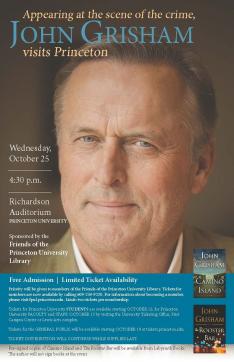John Grisham returned to the scene of his crime. On Oct. 25, the prolific lawyer-turned-writer of legal thrillers discussed his craft in Richardson Auditorium — a short walk away from Firestone Library, the setting of the daring fictionalized heist described in his new novel Camino Island. Grisham’s appearance was sponsored by the Friends of Princeton University Library.
In Camino Island, thieves break into a security vault and get away with the manuscripts of F. Scott Fitzgerald’s five novels, which the University has valued at $25 million but many consider priceless.
Though Grisham centered his story on Fitzgerald and Princeton, he never visited the University to research details. Consequently, the first chapter is “intentionally entirely wrong,” he said. “What could I have done?” he asked rhetorically. “Walk in [to Firestone] and say ‘I want to see these manuscripts because I’m writing a book about somebody stealing them’?”
“It would have been great to come here [for Camino Island] and walk through the library and get it right. I also knew that by getting it wrong, only a handful of people will know — the people here. The other five million will never know,” Grisham said to laughs from the audience.
The idea for Camino Island came after Grisham heard an NPR report about thefts of rare books from libraries, many of which did not have elaborate security systems. Working on his plot, Grisham considered a heist of Hemingway’s or Steinbeck’s papers — but these are scattered in several places across the country. William Faulkner’s manuscripts are big and bulky and would be hard to steal. He chose Fitzgerald’s works for the book because there are only five manuscripts in one location. Then the story just took off, Grisham said.While on campus, the author was given a library tour and saw the Fitzgerald papers first-hand — a “special moment,” he said. “It was very moving because the papers are 100 years old and you can see how Fitzgerald revised and revised and crossed out whole pages of his work.”
Author of more than 30 bestsellers whose books in print number more than 300 million, Grisham affably related how his writing career began as well as his technique. After working 10 years as a lawyer (“I didn’t love it”), he published A Time to Kill, which was “a total flop,” he says. He decided to write one more book, something more commercial, and if it didn’t sell he’d give up writing. When The Firm was published in 1991, it spent 47 weeks on The New York Times best-sellers list and Grisham’s career changed overnight. He then began producing one legal thriller each year.

